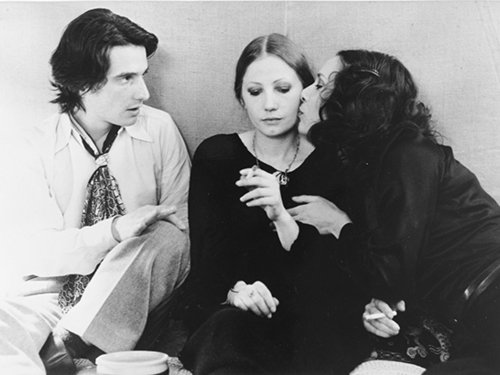
The chauvinist Alexandre balances relationships with several women, including the maternal Marie and the sexually liberated Veronika, in the post-1968 intellectual scene of Paris.
“The audience was with him once, when he made the most beautiful French film of the decade, The Mother and the Whore. Without him, we would have no face to set to the memory of the lost children of May '68: lost, already aging, talkative and old-fashioned. (Bernadette) Lafont, (Jean-Pierre) Léaud and especially Françoise Lebrun, her black shawl and her stubborn voice. Without him, nothing would have remained of them.”
Serge Daney1
“It was shot in Eustache's apartment. The dialogues came from surreptitiously tape-recorded conversation-performances. The model for the ‘mother’ character, ex-girlfriend Catherine Garnier, worked on the film's crew – and committed suicide after seeing a rough cut (Eustache discovered the body). Lebrun had also been a girlfriend of Eustache's for ten on-and-off years; she was his assistant on The Virgin of Pessac (her character, Veronika, was inspired by the director's dalliance with Marinka Matuszewski, a young nurse of, per Evane Hanska's 2001 memoir, ‘loose habits and language’).
Following his one great success, The Mother and the Whore, he'd gained a reputation as a a chronic gambler and a flamboyant wreck; ‘Jack Daniels’ is, tellingly, the credited technical adviser on the film...”
Nick Pinkerton2
“Eustache was a kind of ‘provincial’ cousin to the Nouvelle Vague filmmakers: he was from the South and much younger than every other Nouvelle Vague filmmaker, who did not take him seriously. Suddenly, Eustache makes a film that every single director of the Nouvelle Vague had dreamed of making. He made the film Rivette, Godard, Rohmer and Truffaut would have died to make and every single one of them knew it – La maman et la putain, of course. It’s the ultimate Nouvelle Vague film, except that it doesn’t come from a Nouvelle Vague filmmaker.”
Olivier Assayas3
“In 1982, the year that followed the director's death [he shot himself in the heart at the age of 42], the French literary magazine Les Nouvelles Littéraires paid a special tribute to Jean Eustache by devoting a series of articles to La Maman et la Putain to mark the tenth anniversary of its release. In one of the articles, Jean Douchet mentions that Eustache used to describe the film as ‘a string of apparently insignificant events.’ When discussing his reactions for making the film, Eustache also stated that one of his ambitions was to show how, in a person's life, decisive moments are often immersed in a continuous flow of trivial actions and do not necessarily stand out as significant turning points.
The film reflects this: there is no strong narrative development and the editing creates the impression of a series of disjointed events [‘It took three months of editing to make this film seem unedited,’ wrote Pauline Kael]. For instance, different episodes are sometimes separated by fade-outs to black, which does not allow spectators to establish causal links between them. The film can also just abruptly cut to a different time and place and, although there seems to be a chronological order, the time that has elapsed between two sequences is kept rather vague. Finally, it takes three hours of a meandering progression for the minimal sentimental plot to reach a climax.
Despite giving an impression of spontaneity, the characters' words were in fact very carefully scripted and there was no room for improvisation during the shooting. All the long monologues were read out by the actors who had a piece of paper in their lap or a board in front of them in order to make sure they were saying the exact words of the original script that was about three hundred pages long. It is equally remarkable that Alexandre uses the formal and totally unrealistic ‘vous’ when adressing his lovers. This form of address, which belongs more to the literature of the past than to the casual and egalitarian 1970s, along with Léaud's theatrical acting style, also stresses the fictional nature of the characters and contributes to undermining the suspension of disbelief.”
Martine Pierquin4
“The emblematic New Wave performers [Léaud and Lafont] play further extensions of the characters they've developed over the intervening years. (Even Isabelle Weingarten, who played the lead in Bresson's Four Nights of a Dreamer, carries that credential – “Une femme peut me plaire parce qu’elle a joué dans un film de Bresson,” Léaud says in the film.) But Françoise Lebrun, a graduate student in modern literature who has never acted on the screen before, is completely Eustache's; she gives the picture its sullen, scratched soul. One may guess that her sad, deceptively placid face, with its suggestion of a badly used madonna, inspired Eustache. She has the sort of young-old face that a moviemaker could easily project onto; she's like a beat-out version of the young Dietrich, with her pale-gold braid around her head, as the innocent peasant, soon to be fallen woman, in The Song of Songs, the hokey old Mamoulian-Sudermann film of innocence betrayed. Lebrun's wide-eyed face is blankly opaque – the face of a woman locked in her miseries. She keeps a sullen, suffering deadpan, and as the torrent of obscenities and complaints pours out, we can all project onto that face.”
Pauline Kael5
- 1Serge Daney, “Le fil (mort de Jean Eustache),” Libération, Novembre 16, 1981, translated by Steve Erickson.
- 2Nick Pinkerton, “His Little Loves: The life and films of Jean Eustache,” Moving Image Source, June 12, 2008.
- 3“An Interview with Olivier Assayas,” Screening the Past, October 2014. This interview was conducted by Raffaele Caputo, Rolando Caputo and Clare Stewart, and first appeared in Metro (nr. 113/114) under the title “La femme d’Est”.
- 4Martine Pierquin, “La Maman et la Putain, The Mother and the Whore,” In Phil Powrie (ed.), The Cinema of France (London: Wallflower Press, 2006): 136, 139.
- 5Pauline Kael, “The Used Madonna,” The New Yorker, March 4, 1979, 85.